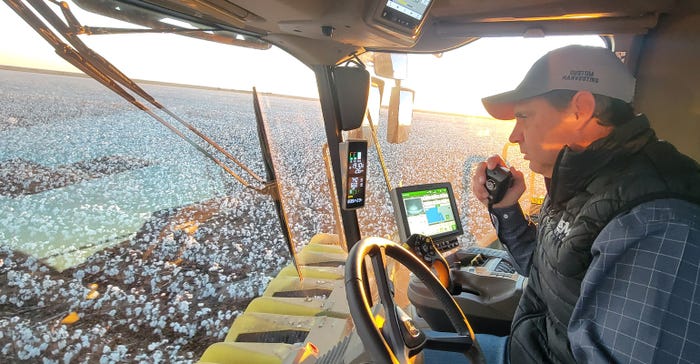
Farwell, Texas, cotton producer Ryan Williams harvests his 2022 crop. He's stripping cotton on a farm that's been in his family for almost 100 years. Shelley E. Huguley
Cotton harvest is underway. Farwell, Texas, cotton producer Ryan Williams admits it's been one of the most challenging years since his first crop in 1998. As he strips his irrigated cotton, he's thankful they persevered.
"It's been really dry. You couldn't hardly get a crop up and going. It took all we had just to meet moisture with irrigation," he says. "We just never got rain."
Williams Farms is a family operation including Ryan's father Mark and his brother Russell and their families. Many of their farms, from Farwell to Dalhart, went a year -- August to August -- without rainfall. "We got rain in late August," Ryan says. "It helped some of the other crops, but it didn't help the cotton a whole lot. So, it was very challenging."
Yields will be "all over the board." The season began with 8,200 planted acres but Ryan says, they "officially lost" their 4,200 dryland acres a couple of weeks ago.
Of the 4,000 irrigated acres remaining, Ryan expects yields to be off by a third. "I would say average of what we call irrigated, will make a bale-and-a-half to two bales. We have a few good fields, but overall, we're significantly down from normal."
Their irrigation, like many drawing from the Ogallala Aquifer, is supplemental. Robbie Lamb has farmed for the Williamses for 12 years. He says even farms with "a little more water," had to be replanted.
"Whenever we were planting, it was so hot and dry, we couldn't get the sprinklers around fast enough. By the time we got around, the cotton had already sprouted and died. So, we had to replant quite a bit this year."
One field planted twice was the Williamses' homeplace, a farm that's been in their family for nearly 100 years. "That field actually turned out pretty nice," Ryan says, adding that it is typically one of their best-yielding farms. "It made 4.2 bales to the acre last year, and 4.4 the year before. This year, I think it will make maybe 3 bales."
On some fields, Ryan concentrated the irrigation on only half the circle. Standing in one of those fields, he says that the half that received limited irrigation will yield 600 to 700 pounds. "That's still a yield and that's better than a zero on your insurance.
"We go down swinging," he adds. "We try to produce all we can. We have some really good cotton because we worked at it, and we got it in the ground. It's hard for us to just quit. I'm glad we kept pressing on."
Whether contracted with Allenberg Cotton or sold on the open market, Ryan is pleased with the price. "I think that's one reason I was committed to keep pushing is because I have some of it priced high."
Marketing cotton is complicated, he admits. "It's just a tough crop to market because we don't know how much we're going to have or the quality. It's a challenge."
Nothing new
Weathering drought is nothing new to Ryan. He says the first year he returned to the farm, it was the driest year on record.
"That was 25 years ago. I don't know how much I learned but I do remember that summer being dry," he recalls. "We had a lot of corn during those times, and we couldn't keep up."
This summer, although similar, was more challenging, "because we have less water. Our irrigation capacity is less and that made it harder to keep up and when you can't even get a crop up, it's very frustrating."
But Ryan doesn't give up easily. You could say he interprets frustrations as challenges. "A lot of people threw their hands up and said, 'We're not even going to try. It's too dry.' But I'm stubborn and an eternal optimist, so I push through. It pays off, for the most part. Sometimes, I should have probably quit those certain circles, but I just don't have that in me."
Catch a glimpse of the sun setting on cotton harvest with Ryan Williams in this photo gallery.
About the Author(s)
You May Also Like






